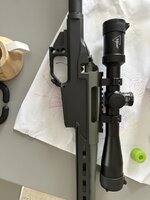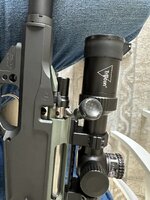Depends on MERI take back all the good things I said about my gun smith. He keeps making me make decision I don’t like making.
16.5” or 18” barrel. Both are on the shelf!
Help me!
Navigation
Install the app
How to install the app on iOS
Follow along with the video below to see how to install our site as a web app on your home screen.
Note: This feature may not be available in some browsers.
More options
Style variation
You are using an out of date browser. It may not display this or other websites correctly.
You should upgrade or use an alternative browser.
You should upgrade or use an alternative browser.
Let’s build a youth forever rifle!
- Thread starter Ucsdryder
- Start date
Ucsdryder
Modern Fuddster
- Joined
- Jan 24, 2015
- Messages
- 7,615
Haha i knew that was coming. Its so hard to get away from the more velocity the better mindset!Depends on MER
sierracharlie338
WKR
I’m in the lowlands of Texas so I’d opt for the 18 but if you’re higher up 16.5 would prob be fine for her hunting rig.I take back all the good things I said about my gun smith. He keeps making me make decision I don’t like making.
16.5” or 18” barrel. Both are on the shelf!
Help me!
wind gypsy
"DADDY"
- Joined
- Dec 30, 2014
- Messages
- 12,612
I take back all the good things I said about my gun smith. He keeps making me make decision I don’t like making.
16.5” or 18” barrel. Both are on the shelf!
Help me!
Sounds like a carbon barrel problem. Neither
Ucsdryder
Modern Fuddster
- Joined
- Jan 24, 2015
- Messages
- 7,615
Haha I was going to keep that part to myself! Yeah I went CF. Gemma’s request..she thinks the gray swirls are pretty. It’s hard to argue with her. 18” was her request over 16.5” so we’re moving forward.Sounds like a carbon barrel problem. Neither
Defiance classic
18” proof sendero CF
trigger tech special
I might have gotten a little ahead of myself with this build, when I was her age I was shooting a 5 times hand me down rifle.
Last edited:
Density altitude (DA) is a single number composite of altitude, barometric pressure, and temperature.*** Basically, if barometric pressure and temp are held constant, it is the altitude you would be at.I don't have time to google immediately, DA...
So, you are at sea level? I think 7-10k feet in Colorado would be an easy 500yds.
I live at see level, in the 8 months I have been paying attention to it my DA has ranged from -7000 to 3500 feet. The actual altitude is unchanged, but bullet behavior is effected quite a bit.
The -60 example above would be a DA of -13,000 feet.
***For the pedantic nerds like myself, DA is derived from temp, station pressure, and dew point temperature. The actual calculation is complex enough I would not mess with it.
Yes sir an actual full DA calculation is always ideal and the most accurate but it’s almost never really feasible when hunting. By the time someone gets all of their current weather and full data into an app and get a calculation, lots of times the opportunity has gone by. Or the yardage has changed, etc.Density altitude (DA) is a single number composite of altitude, barometric pressure, and temperature.*** Basically, if barometric pressure and temp are held constant, it is the altitude you would be at.
I live at see level, in the 8 months I have been paying attention to it my DA has ranged from -7000 to 3500 feet. The actual altitude is unchanged, but bullet behavior is effected quite a bit.
The -60 example above would be a DA of -13,000 feet.
***For the pedantic nerds like myself, DA is derived from temp, station pressure, and dew point temperature. The actual calculation is complex enough I would not mess with it.
If you factor in just elevation and temp, and have some pre made cards based on the forecast and known elevations, it’s much faster. I have little laminated cards on a key ring in an outside pouch of my pack. The elevations are different colors and then they are sorted by temp low to high.
I can confidently say in my experience with just about all hunting shots out to 1,000 yards that just using temp and elevation into the calculation is near identical to doing a full DA calculation.
You’re going to miss because of a poor shot or a poor wind call way before you’ll miss because you didn’t do a full DA calc and just used elevation and temp instead. At least, that’s what I’ve seen in the field.
The cards are a good back-up. Within the ranges I well shoot at an animal +/- 2500 feet DA is just fine (5000 ft DA change at 500 yards is a 2.3 inch POI change (0.1 mil) and 100 fps difference in impact velocity) for my gun/bullet. So looking at the Kestrel when there are large changes in temp/barometer/elevation and just remembering that for the next few hours works fine. For most shots, were I hunt, knowing quick drop calculations for 3000 ft DA gets me within margin of error.Yes sir an actual full DA calculation is always ideal and the most accurate but it’s almost never really feasible when hunting. By the time someone gets all of their current weather and full data into an app and get a calculation, lots of times the opportunity has gone by. Or the yardage has changed, etc.
If you factor in just elevation and temp, and have some pre made cards based on the forecast and known elevations, it’s much faster. I have little laminated cards on a key ring in an outside pouch of my pack. The elevations are different colors and then they are sorted by temp low to high.
I can confidently say in my experience with just about all hunting shots out to 1,000 yards that just using temp and elevation into the calculation is near identical to doing a full DA calculation.
You’re going to miss because of a poor shot or a poor wind call way before you’ll miss because you didn’t do a full DA calc and just used elevation and temp instead. At least, that’s what I’ve seen in the field.
At the moment my hard limit on an animal is 400 yards, if I get enough mountain shooting and reliable get 90% first round hits, I will push it out as far as 600 yards and DA accuracy will be a little more important. I'll shoot for fun at longer ranges though.
I suspect I just found another articulation of the argument for high BC bullets even when something else will work.
I like where you’re at on this topic. I wouldn’t think a difference in full DA calc and a temp/elevation calc only would have a 2.3” discrepancy at 400 yards. I need to search for a thread on this topic as I probably have some things to learn and then go try. Won’t clutter up this one.The cards are a good back-up. Within the ranges I well shoot at an animal +/- 2500 feet DA is just fine (5000 ft DA change at 500 yards is a 2.3 inch POI change (0.1 mil) and 100 fps difference in impact velocity) for my gun/bullet. So looking at the Kestrel when there are large changes in temp/barometer/elevation and just remembering that for the next few hours works fine. For most shots, were I hunt, knowing quick drop calculations for 3000 ft DA gets me within margin of error.
At the moment my hard limit on an animal is 400 yards, if I get enough mountain shooting and reliable get 90% first round hits, I will push it out as far as 600 yards and DA accuracy will be a little more important. I'll shoot for fun at longer ranges though.
I suspect I just found another articulation of the argument for high BC bullets even when something else will work.
Edit: Just did a quick calculation as if I was to take an 800 yard shot at a 12” target with the current weather data.
Actual elevation 2,200. Density altitude based on current data is 110 degrees, 29.7 station pressure, and 56 degree dew point makes for 3,625 DA.
With my .260 shooting 129 SST…
Using just elevation and temp:
MIL UP: 5.7
Impact velocity: 1,708
Using DA calc:
MIL UP: 5.6
Impact velocity: 1,762
Last edited:
- Joined
- Oct 22, 2014
- Messages
- 13,315
I like where you’re at on this topic. I wouldn’t think a difference in full DA calc and a temp/elevation calc only would have a 2.3” discrepancy at 400 yards. I need to search for a thread on this topic as I probably have some things to learn and then go try. Won’t clutter up this one.
Edit: Just did a quick calculation as if I was to take an 800 yard shot at a 12” target with the current weather data.
Actual elevation 2,200. Density altitude based on current data is 110 degrees, 29.7 station pressure, and 56 degree dew point makes for 3,625 DA.
With my .260 shooting 129 SST…
Using just elevation and temp:
MIL UP: 5.7
Impact velocity: 1,708
Using DA calc:
MIL UP: 5.6
Impact velocity: 1,762
Check your numbers again. You are over 6,000fy DA with those numbers.
I don't think it would, that number was to show that a 5000 ft DA error is only off by 2.3" at 400 yards. The temp/elevation method would by much closer than that, even if guessing temp based on feel and allowing for error in elevation I doubt you would be off by over 1000 ft DA from measured (based on what Form has said, it will probably be closer than that)I like where you’re at on this topic. I wouldn’t think a difference in full DA calc and a temp/elevation calc only would have a 2.3” discrepancy at 400 yards. I need to search for a thread on this topic as I probably have some things to learn and then go try. Won’t clutter up this one.
I used a quick free online calculator entering the values. I wonder what this one isn’t taking into account to come up with value?Check your numbers again. You are over 6,000fy DA with those numbers.
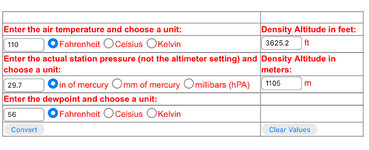
I moved away from DA calculators when I quit shooting comps and long range varmint comps 10 years ago. It’s been a while.
I’ve honestly just used current temp and current elevation with cheat cards and have had great success on big game out to 1,000 yards. I guess it’s a good thing they are big targets haha.
I’ll start a new thread and tag a few folks in there to discuss further, unless there is some data somewhere already?
Thanks.
Last edited:
- Joined
- Oct 22, 2014
- Messages
- 13,315
I used a quick free online calculator entering the values. I wonder what this one isn’t taking into account to come up with value?
View attachment 745613
I moved away from DA calculators when I quit shooting comps and long range varmint comps 10 years ago. It’s been a while.
I’ve honestly just used current temp and current elevation with cheat cards and have had great success on big game out to 1,000 yards. I guess it’s a good thing they are big targets haha.
I’ll start a new thread and tag a few folks in there to discuss further, unless there is some data somewhere already?
Thanks.
There is something not correct about that.
This is what you should be getting, or something close-
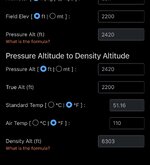
Using a DA chart with just temp and elevation puts it between 6,100 and 6,200 ft DA. Using just real temp and real elevation results in not more than a 100 foot or so difference in DA than absolute correct DA.
Makes sense.There is something not correct about that.
This is what you should be getting, or something close-
View attachment 745617
Using a DA chart with just temp and elevation puts it between 6,100 and 6,200 ft DA. Using just real temp and real elevation results in not more than a 100 foot or so difference in DA than absolute correct DA.
I just threw it all in Strelok pro for fun, using my phones weather app to give me a calc with my .260 at 800 yards. The result was up 5.6 MIL which is within .1 MIL of what I would have used for elevation dial for that shot if I went out and did that shot right now.
Sorry @Ucsdryder Ill make a new thread to discuss this in a bit.
Ucsdryder
Modern Fuddster
- Joined
- Jan 24, 2015
- Messages
- 7,615
nope, I’m following along too. I’ve been using zeiss RFs for the last 4 years so took a lot of this for granted. I just googled it, the pilots take this shit seriously!Makes sense.
I just threw it all in Strelok pro for fun, using my phones weather app to give me a calc with my .260 at 800 yards. The result was up 5.6 MIL which is within .1 MIL of what I would have used for elevation dial for that shot if I went out and did that shot right now.
Sorry @Ucsdryder Ill make a new thread to discuss this in a bit.
Right on. We used to go crazy with it at the VHA competitions and qualifiers. Trying to get confirmed kills on varmints at over 2,000 yards take a special kind of idiot (me).nope, I’m following along too. I’ve been using zeiss RFs for the last 4 years so took a lot of this for granted. I just googled it, the pilots take this shit seriously!
KChunter71
WKR
- Joined
- Jul 20, 2016
- Messages
- 1,625
@Travis Bertrand , you have a picture of her rifle all set up?I built my daughter a 6.5prc with a short barrel (18-20”) in an XLR chassis. She runs the tlr stock or whatever it’s called. It has a ton of adjustability and just keeps growing with her.
I chose prc because it can handle any game she will encounter. She killed an elk with it at 609 yards and her buck at 700. With a brake and in your case, a can, that is key along with a gun that fits her.
If it fits her and she’s not scared of it, she will kill with it.
Sent from my iPhone using Tapatalk
@Ucsdryder any updates on her rifle?
I’m looking at a MDT, XLR, or manners adjustable LOP for my 8y son. It’s not much more to get a XLR chassis and buy use an AR buffer and stock.
I was just getting ready to to make a post about this. Figured I’d tag along on some other builds already done.
Have 3 tikkas 223, 6.5cm, and 6.5prc.
So his tikka 223 will be going in it. He can shoot it to 300yds on a 12”gong. But the standard LOP is long for him right now.
@Formidilosus thought on adjustable LOP tikka stocks?
Ucsdryder
Modern Fuddster
- Joined
- Jan 24, 2015
- Messages
- 7,615
@Travis Bertrand , you have a picture of her rifle all set up?
@Ucsdryder any updates on her rifle?
I’m looking at a MDT, XLR, or manners adjustable LOP for my 8y son. It’s not much more to get a XLR chassis and buy use an AR buffer and stock.
I was just getting ready to to make a post about this. Figured I’d tag along on some other builds already done.
Have 3 tikkas 223, 6.5cm, and 6.5prc.
So his tikka 223 will be going in it. He can shoot it to 300yds on a 12”gong. But the standard LOP is long for him right now.
@Formidilosus thought on adjustable LOP tikka stocks?
Yep, waiting on a barrel at the moment. Earl Fouraker is building it, so I’m quite confident it’ll outshoot my abilities.
We decided on a 22” 25prc. The original plan was a 6cm, but she shoots my 7saum very well and the ballistics of the 134 eldm and 138 atip Hornady bullets around 3000fps are very attractive!
The Xlr chassis came in. She’s pretty. I’ll update more when all the components arrive!
Regarding LOP adjustment, the carbon fiber but pad is 12.5” without the folder, 13.5 with the folding adapter. I also picked up the tr2 which is adjustable from ~10.5” to 14” by my calculations.
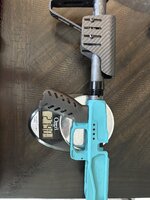
Last edited:
bojangles808
WKR
@Travis Bertrand , you have a picture of her rifle all set up?
@Ucsdryder any updates on her rifle?
I’m looking at a MDT, XLR, or manners adjustable LOP for my 8y son. It’s not much more to get a XLR chassis and buy use an AR buffer and stock.
I was just getting ready to to make a post about this. Figured I’d tag along on some other builds already done.
Have 3 tikkas 223, 6.5cm, and 6.5prc.
So his tikka 223 will be going in it. He can shoot it to 300yds on a 12”gong. But the standard LOP is long for him right now.
@Formidilosus thought on adjustable LOP tikka stocks?
Here's an ultradyne ud5 chassis in a Tikka 223. It's 9lbs 5oz setup with the tr2 buttstock (ud5 is 22oz). Lop in this setup is just under 10.5 in. It gets a little weird with the bolt and if you use the bag rider on the tr2 but I dont think there's anything better for adjustability for youth. I also rebarreled a savage 30-06 that's in a cheap outlier chassis that I can swap the same tr2 buttstock on and then I have the folder with smoke buttstock that I can make this 223 full size again. Realizing I'm not a big chassis guy from a shooting experience standpoint (will probably pm you before i list the ud5 with folding XLR smoke buttstock), but the ability to swap around buttstocks for adjustability between different shooters really is unmatched on this xlrish type platform.
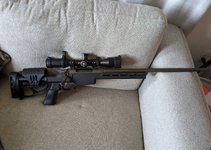
Last edited:
Just got a UD 5, very impressed with price point and workmanship. Here is my biggest gripe and I haven’t had it in the field just yet, but it was kind of driving me nuts yesterday when I was assembling it. The fact the trigger is partially exposed while seated in the chassis. I’m not too hard on my stuff but often 3/4th rifle brings lots of snow and that didn’t thrill me. I cannot say enough about how easy UD is to deal with and shipping times and communication. They are a fantastic company. Maybe I’m just being a stickler but it drives me nuts seeing that portion of the trigger exposed. Have you have field experience with yours?Here's an ultradyne ud5 chassis in a Tikka 223. It's 9lbs 5oz setup with the tr2 buttstock (ud5 is 22oz). Lop in this setup is just under 10.5 in. It gets a little weird with the bolt and if you use the bag rider on the tr2 but I dont think there's anything better for adjustability for youth. I also rebarreled a savage 30-06 that's in a cheap outlier chassis that I can swap the same tr2 buttstock on and then I have the folder with smoke buttstock that I can make this 223 full size again. Realizing I'm not a big chassis guy from a shooting experience standpoint (will probably pm you before i list the ud5 with folding XLR smoke buttstock), but the ability to swap around buttstocks for adjustability between different shooters really is unmatched on this xlrish type platform.
Attachments
Similar threads
- Replies
- 0
- Views
- 242
Featured Video
Latest Articles
- TT#64 Josh Boyd Elk Hunting Strategies for Every Season
- Aaron Davidson of Gunwerks
- TT#63 Dirk Durham’s Art of Elk Calling
- BIG Buck Stories with the Dirty Giants Podcast
- TT#62 Brian Barney Hunting Bulls without Calling
- Hoyt Alpha AX-2 SD Review
- Kuiu Kenai vs Outdoor Vitals Vario Hooded Jacket Review
- Hoyt RX-9 Ultra Review
- Hunting Vampire Bucks & Building an Optics Kit
- Darton Sequel ST2 35 Review

